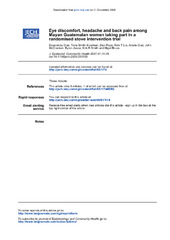Eye discomfort, headache and back pain among Mayan Guatemalan women taking part in a randomised stove intervention
Díaz, Esperanza; Smith-Sivertsen, Tone; Pope, Dan; Lie, Rolv Terje; Díaz, Anaité; McCracken, John; Arana, Byron; Smith, Kirk R.; Bruce, Nigel
Peer reviewed, Journal article
Permanent lenke
https://hdl.handle.net/1956/3432Utgivelsesdato
2007Metadata
Vis full innførselSamlinger
Originalversjon
https://doi.org/10.1136/jech.2006.043133Sammendrag
Background: Indoor air pollution (IAP) from combustion of biomass fuels represents a global health problem, estimated to cause 1.6 million premature deaths annually. Aims: RESPIRE (Randomised Exposure Study of Pollution Indoors and Respiratory Effects) Guatemala is the first randomised controlled trial ever performed on health effects from solid fuel use. Its goal is to assess the effect of improved stoves (planchas) on exposure and health outcomes in a rural population reliant on wood fuel. Methods: Questions about symptoms were asked at baseline and periodically after the intervention, to an initial group of 504 women (259 randomly assigned to planchas (mean (standard deviation) age 27.4 (7.2) years) and 245 using traditional open fires (28.1 (7.1) years)). Levels of carbon monoxide (CO) in exhaled breath, a biomarker of recent exposure to air pollution from biomass combustion, were measured at each visit. In addition to reducing IAP levels, the plancha may also have a positive health effect by changing the working posture to an upright position. Results: A high prevalence of eye discomfort, headache and backache was found. The odds of having sore eyes and headache were substantially reduced in the plancha group relative to the group using open fires for the follow-up period (odds ratio (OR) 0.18, 95% confidence interval (CI) 0.11 to 0.29 and (OR) 0.63, 95% CI 0.42 to 0.94, respectively). Median CO in breath among women in the intervention trial was significantly lower than controls. Conclusion: In addition to reducing discomfort for women, tangible improvements in symptoms experienced by a substantial proportion of women may help to gain acceptance and wider use of planchas.
